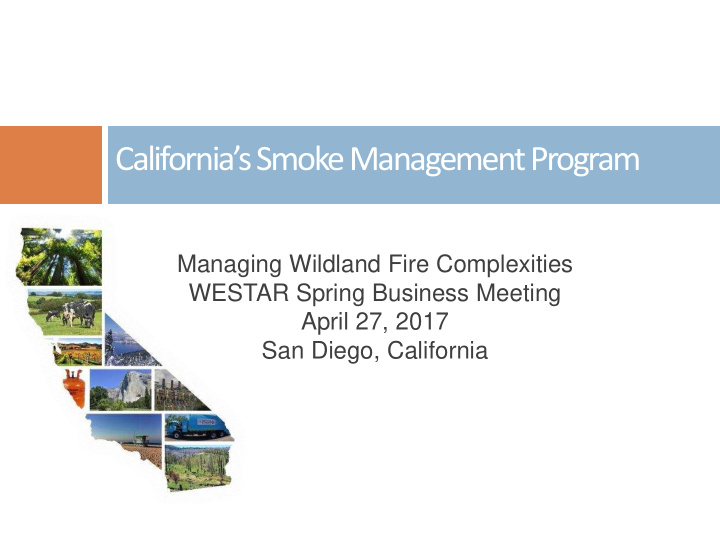



California’s Smoke Management Program Managing Wildland Fire Complexities WESTAR Spring Business Meeting April 27, 2017 San Diego, California
Historic Role of Fire Fire has always been a part of California ’ s landscape • In 1542 Cabrillo named San Pedro Harbor the “ Bay of Smoke and Fir es” • Fire plays an important role in California ’ s forest Ecosystems • Wildfires single biggest source of high-level air quality impacts (in U.S.) • Contributes to more than 40% of US fine particulate matter (PM2.5) based on the EP A ’ s 2011 National Emission Inventory • California averages over 600,000+ acres burned over the past five year • 46,000+ acres of prescribed burning over the past five year
Smoke Management Program Provide increased opportunities for prescribed and agricultural burning, while minimizing smoke impacts • 1300 Call, Daily Communication Between (CARB, FLMs, Air Districts) • Burn Day Determinations Mutual objectives of protecting public health and ensuring healthy and resilient forests (Tree Mortality) 2011 Coordination and Communication Protocol for Naturally Ignited Fires California ’ s air quality standards and climate goals • Meeting air quality standards • Improving visibility • Reducing short-lived climate pollutants • Achieving greenhouse gas reduction targets Changes from 1890 to 1970
Smoke Management Program Sets requirements for: • Daily burn determinations based on meteorological dispersion rates, air quality conditions and the amount of emissions predicted • Burn registration and planning well ahead of time • Public notification procedures • Communications on many levels Prescribed Fire Reporting System (PFIRS) – Serves as a data and information interface between regulators, burners and individuals using wildland fire. • Smoke Management Information distribution system • Public notification interface • Emissions tracking and storage Meteorological Forecasting – High resolution(2km x 2km) smoke weather forecasts via CANSAC
California Air Response Planning Alliance Multi-Agency Partnership ARBs Office of Emergency Response • Meteorological Forecasting • Air Pollution Modeling • Air Monitoring Deployment Guide for smoke response coordination in California Lists recommended health actions. Daily intelligence briefing 1400 Monitoring Call (Smoke response decisions made)
Key Organizational Objectives Messaging Monitoring 6
Monitoring Wildland Fire Smoke Air Quality Management Information System (AQMIS) ARB E-BAMs (30 units) - Portable PM2.5 monitoring instrument USFS E-BAMs Prescribed Fire Information Reporting System (PFIRS) Modis Satellite Images Hazard Mapping System (HMS) BlueSky Modeling System National Weather Service (GOES Satellite, Radar, Winds) 7
Modeling Wildland Fire Smoke USFS AirFire Teams, BlueSky Integrated effort with CANSAC WRF (and others high resolution models) Website automatically generates daily plume models twice a day (select your run). Estimates current and future PM concentration values. Focus on high resolution and customization (newer, faster machine) King Fire 2014 8
Messaging Wildland Fire Smoke Work closely with local air districts and public health agencies Sync communications across impacted areas, and incident commands Create Smoke Outlooks and Impact Summaries • Goal: Reduce exposure through behavior modification Provide critical decision information: • Monitor data • Fire behavior predictions • Incident command decisions Posting on web, blogs, social media
Air Resource Advisors Smoke specialists deployed as part of an Incident Management T eam (THSP in ICS) Enables: • Smoke information within Incident decisions • Allows incident decision information for BlueSky modeling, messaging, etc • Develops outlooks and other documents ARA Deployments by Y ear for communications • Works with local agencies and communities
Multi-Agency Workgroups USEPA, ARB, State and Federal Land Managers, Local Air Pollution Control Districts and NGOs • Air and Land Managers • Interagency Air and Smoke Council • 1300 & 1400 Conference Calls • CANSAC, PFIRS, RX 410 Training Provides a forum to discuss issues regarding air quality and smoke management in California The Goal is Healthy and Sustainable Forests , while protecting public health!
Thank Y ou Dar Mims Smoke Management Coordinator Air Quality Planning and Science Division California Air Resources Board Dar.Mims@arb.ca.gov
Recommend
More recommend